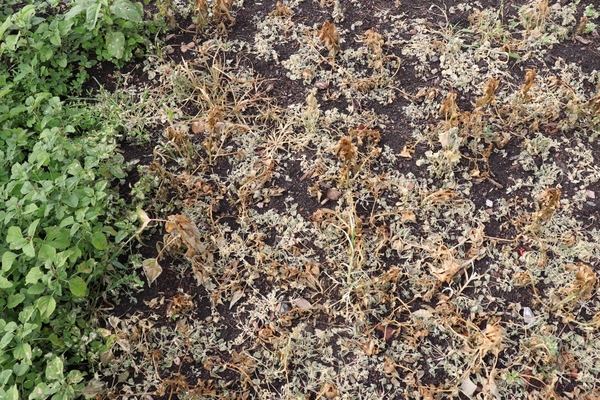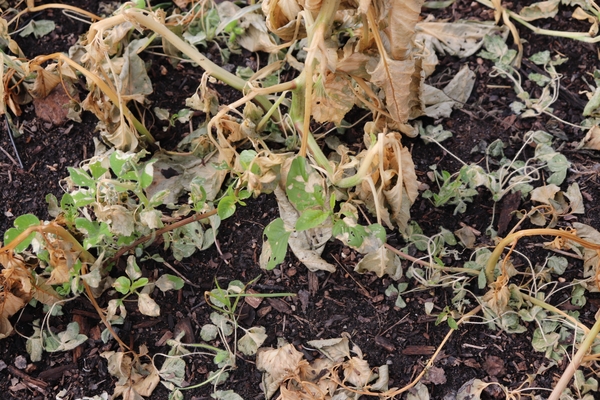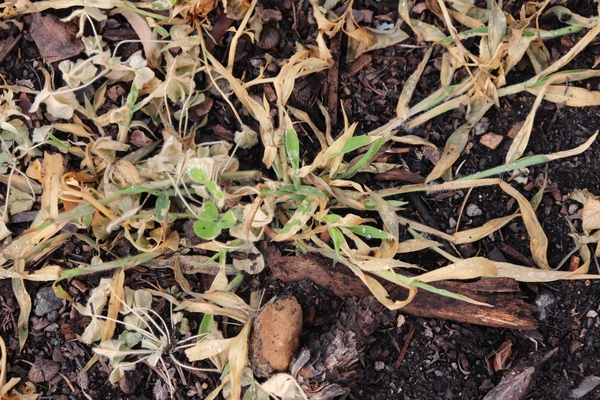Introduction
| Trade Name: Reward | Common Name: diquat dibromide | Formulations: 2L |
Uses
Nonselective, postemergence weed control for use in field and container nurseries, landscape beds, walkways, patios, beneath greenhouse benches, along driveways, and other non-crop areas. Rapid burn-down of weeds with no soil residual. Cool weather does not reduce the efficacy of Reward as dramatically as other postemergence herbicides. For this reason, Reward is often used in the winter and early spring to control winter annual weeds.
| Amount of Active Ingredient | Amount by Formulation | |
|---|---|---|
| 2 L | ||
| Per Acre | 0.25 to 1 | 0.5 to 2 qt |
| Per 100 gal | 0.5 to 1.0 lb | 1 to 2 qt |
| Per 1 gal | 0.166 fl oz | 4 teaspoons |

Nonselective control of seedling weeds. Photo taken 3 days after diquat application.
J. Neal CC BY-NC-ND 4.0

Diquat is a contact action herbicide. Larger weeds or those not contacted by spray can re-grow.
J. Neal CC BY-NC-ND 4.0
Major Weeds Controlled
Nonselective postemergence control of seedling broadleaves and grasses.
Major Weeds Not Controlled
Provides only "top-kill" of perennial weeds and most established annual weeds. Has no soil residual and thus does not affect weeds that emerge after application. Addition of a systemic herbicide in a tank-mix with Reward may be needed for control of established perennial weeds.

Grasses often survive diquat applications because the growing points are protected from contact with the spray.
J. Neal CC BY-NC-ND 4.0

Even 2 applications of diquat did not completely kill crabgrass in this demonstration.
J. Neal CC BY-NC-ND 4.0
For Best Results
A 75 percent nonionic surfactant should be added to the spray solution. Apply for full coverage and thorough weed contact in a minimum of 15 gallons of spray per acre. Higher spray volumes have provided more consistent weed control in North Carolina tests. Best control is achieved if weeds are young when treated. Re-treatment may be necessary for grasses and established weeds.
Cautions and Precautions
Avoid spray contact with desirable vegetation.
Residual Activity
None.
Volatility and Leaching Potential
Nonvolatile. Strongly adsorbed by clay particles in the soil; little leaching expected.
Symptoms and Mode of Action
Interacts with light to produce superoxides that destroy plant cells. On a sunny day, treated tissues will appear water-soaked within hours. Necrosis follows within one or two days. Dead tissue usually turns black. WSSA Group 22. See Photosystem I, Bipyridillium Herbicides.
Additional Information
| Worker Protection Standards | REI: 24 hours |
| PPE: coveralls, chemical-resistant gloves, water-proof footwear + socks, headgear for overhead exposure, apron when cleaning equipment, mixing, or loading, face shield when mixing or loading, protective eyewear | |
| Manufacturer: Syngenta Crop Protection, LLC (and several others) | EPA Reg. # 100-1091 |
Publication date: March 20, 2018
Reviewed/Revised: Dec. 21, 2022
Recommendations for the use of agricultural chemicals are included in this publication as a convenience to the reader. The use of brand names and any mention or listing of commercial products or services in this publication does not imply endorsement by NC State University or N.C. A&T State University nor discrimination against similar products or services not mentioned. Individuals who use agricultural chemicals are responsible for ensuring that the intended use complies with current regulations and conforms to the product label. Be sure to obtain current information about usage regulations and examine a current product label before applying any chemical. For assistance, contact your local N.C. Cooperative Extension county center.
N.C. Cooperative Extension prohibits discrimination and harassment regardless of age, color, disability, family and marital status, gender identity, national origin, political beliefs, race, religion, sex (including pregnancy), sexual orientation and veteran status.
